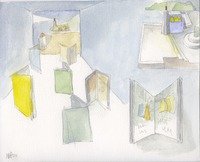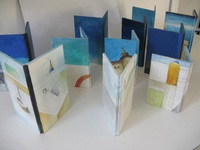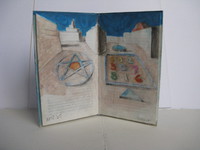I have always regretted throwing away books. Culturally and traditionally they represent knowledge, and their symbolic value doesn't seem to be too diminished by the fact that the vast majority of published books are both uninspired and sometimes even unpleasant.
The image of the Priest raising high for the believers to see the Holy Book, whether it be the Bible or the Koran, to me is something very strong, all the more so as a symbol, as an extraordinary statement of reality: knowledge coupled with transcendence in a representation that brings together, in a single moment, rationality, mystery and the sacred.
(follows) TORRE A NORD OVEST TORRE A NORD OVEST |
 TRE LIBRI TRE LIBRI |
 BOOKS BOOKS |
 LIBRO L1 LIBRO L1 |
 LIBRO L2 LIBRO L2 |
 LIBRO L3 LIBRO L3 |
 LIBRO L4 LIBRO L4 |
 LIBRO L5 LIBRO L5 |
 PIU' LIBRI PIU' LIBRI |
 COLORI NELLA NOTTE COLORI NELLA NOTTE |
 ORIENTE ORIENTE |
Certainly, the sacredness of books descends from the exhibition of religious tomes, or rather it falls, until it disappears in the pages with the least content and material; nevertheless, even in the worst book, I keep finding a symbolic value and this is what is holding me back from sending it for pulping, which is something that reminds me of decomposition in the grave, of both physical and mental annihilation.
So I save some, not all of them of course: the chosen ones, which fate sent to my work of fossilization, mummification according to the illusory rules for stopping time. They contain the values, the loved ones and the heroes, who shaped our history. Books are, after all, an ancient method for preserving memory.
Only the most precious volumes can be kept: The beautiful cotton paper, crisp printing, and the accurate work of the knotter make them objects ready to withstand adversity. This cannot be said of paperback books where poor binding but especially the paper processed with aggressive bleaching acids, which over time, often a short one, turn yellow, disintegrate and crumble. Therefore collecting them is useless, it is just a sad parody of the vanity of things.
There are two extreme cases: books that are not interesting, but are handsomely made and books of high content in paperback edition, therefore an endangered species. Both become the object of my care of meticulous embalmer, who cauterizes the wounds of time. First of all, a good cover and the stiffening of the entire tome and its pages is required in order to preserve its content and its essence as a book. With this kind of protection, it looks solid but it can still be opened and closed as the supports of certain Byzantine icons and of other objects of worship, which can be transported and occasionally contemplated.
Then I begin the decorative intervention or illustration, or more conceptually, the intervention on the text, which sometimes remains half hidden, sometimes disappears beneath the painting and the fantasies of my mental journeys, which still persist and stimulate me to tell stories.
Alberto Maria Prina
